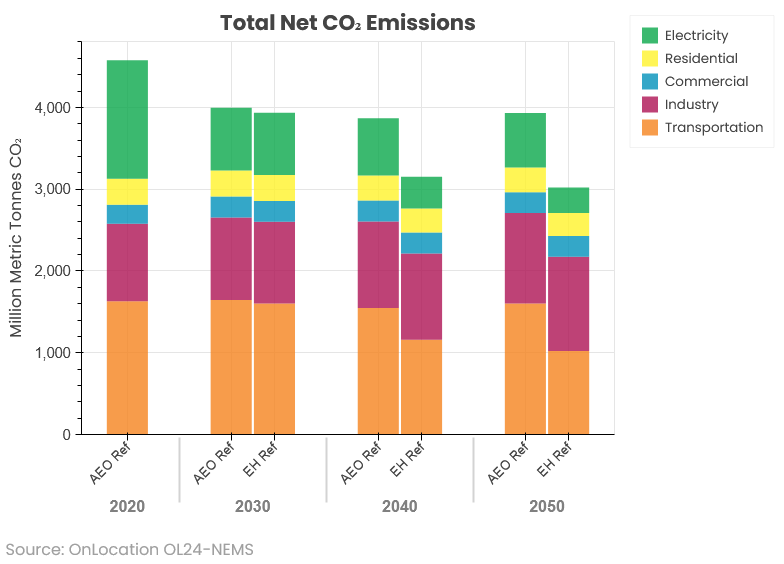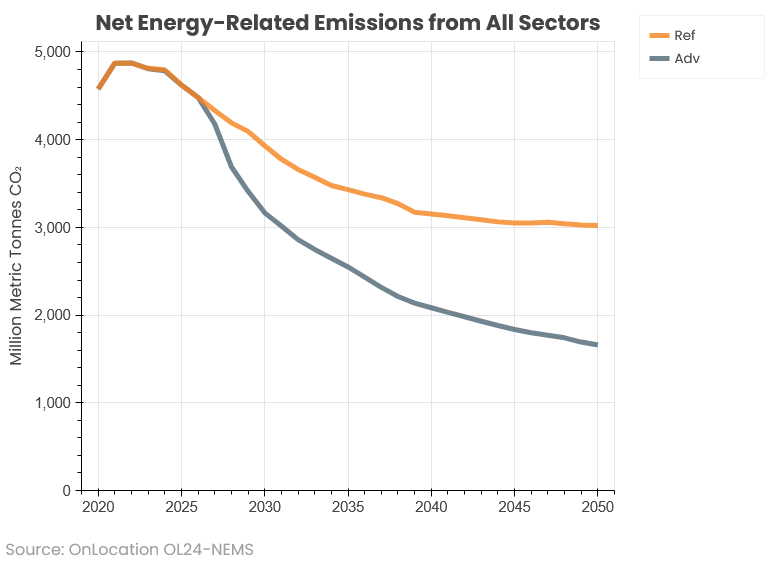On June 27, 2024, OnLocation hosted a webinar and will later release its long-term energy outlook report, U.S. Energy Horizons to 2050. View the webinar recording, download our presentation, or read the transcript. The report projects potential future effects on energy supply and demand for the U.S. energy system, which is expected to undergo a significant transition over the next quarter century due to the adoption of new technologies, plus changes in policy, and in consumer choice.
OL EH considers the impact of existing and potential policies and technologies affecting energy-related greenhouse gas emissions. OL-NEMS is based on the previous year’s U.S. Energy Information Agency’s Annual Energy Outlook (EIA AEO 2023). OnLocation updated this model with publicly available data, policy updates, and new capabilities, making OL EH markedly different from EIA’s AEO 2023.
Citing the need for more time to incorporate new features to the underlying NEMS model to reflect recent energy system changes, the EIA announced they would not release an AEO for 2024. This is the first year since the early 1980’s that EIA did not produce an AEO.
OnLocation decided to produce the OL EH this year for the benefit of the energy & climate modeling community to better understand the resulting new market dynamics, industry challenges, and changes in energy-related greenhouse gas emissions. Over its 40-year history, OnLocation has worked with EIA to build and maintain parts of NEMS, the energy-economy model used to produce AEOs.
OL-NEMS is OnLocation’s customized version of the National Energy Modeling System (NEMS), shown in the below schematic.

Figure 1: OL-NEMS is a Modular Energy Model Based Largely on U.S. Energy Information Administration’s NEMS (Source: OnLocation)
Scenario Formulation
The Horizons report provides Reference and Advanced Technologies scenarios to illustrate the impacts of clean technology innovation and enabling policies that could lead to deeper decarbonization.
OL EH is a series of modeled projections under different sets of consistent input assumptions. Although many input assumptions (e.g., prices, technology development, economic growth, geopolitical developments) are uncertain long-term, OnLocation uses the best judgment of its energy experts, informed by historical trends and expected future changes, to develop quantitative central pathways for model input assumptions. These central pathways produce the OL EH Reference scenario and may be adjusted in sensitivity scenarios to illustrate impacts of parameter uncertainty on the energy system.
Key Findings
Our major modifications in OL-NEMS lead to greater CO2 reductions in most energy sectors by 2050 compared to AEO 2023, especially in the power and transportation sectors, as indicated in Figure 2 below.

Figure 2: Total Net CO2 Emissions AEO23 Reference vs OL EH Reference (Source: OnLocation OL24-NEMS)
While Reference scenario CO2 emissions decline over time, net emissions in the Advanced Technologies scenario are much lower than the Reference scenario (Figure 3).

Figure 3: Total Net CO2 Emission EH Ref vs Adv Tech (Source: OnLocation OL24-NEMS)
An important contributor to these reductions is that the power sector achieves net zero CO2 by 2040 with a combination of new renewables, battery storage, and CO2 capture including bioenergy with carbon capture (BECCS). Some other sectoral emissions are offset by net negative emissions from both DAC and BECCS in industry, biofuels, and hydrogen production.
OL EH is accessible for organizations aiming to more effectively explore potential future projections of the U.S. energy system and identify strategies for influencing its direction. Additional OnLocation reports on Data Center (AI & Cryptocurrency) Energy Demands, Employment Impacts of the U.S. Energy Transition, and Critical Materials Demands of the U.S. Energy Sector are planned for later this year.